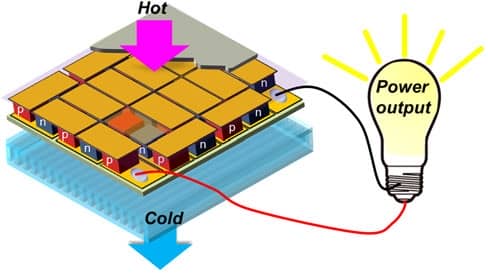Energy is the biggest concern of life today and even more so is clean energy. Researchers have been trying to develop ways of harnessing clean energy for decades. Wind, tide, and solar have become more of conventional power sources that are widely used today. A researcher at the Purdue University has given a different twist to the way we look at clean energy by developing a thermoelectric fabric that harnesses human body heat and turns it into electricity to power IoT devices.
Body heat could power IoT devices, medical monitors w. thermoelectric flexible fabric. https://t.co/m1oiHtJdYR @DiscoveryParkPU @PurdueOTC pic.twitter.com/dUAxOqM6pO
— Research at Purdue (@Research_Purdue) April 7, 2017
Kazuaki Yazawa is an associate professor at Discovery Park’s Birck Nanotechnology Center at Purdue University who has developed a thermoelectric fabric made up of semiconductor strings, which extracts body heat and turns it into small amounts of electricity. The semiconductor strings are integrated into the fabric and absorb heat from any direct contact point and convert it into electrical power.
Such a thermoelectric fabric has a wide variety of applications. The first that comes to anyone’s mind would be clothing covering the entire body, serving as a very good heat source. It could be used in tech wearables and many medical and athletic applications. The material could also be wrapped around objects like coffee cups and chimneys that otherwise radiate the heat, wasting it away.
Enlisting the numerous applications of the tech, Yazawa said:
“Heart monitors, respiration and perspiration monitors are very useful for the elderly or those recovering from a trauma. There also is a huge market for wearables in sports to optimize human performance. If you have a patient or an athlete who is overheating, real-time information of their vitals could be used by coaches and medical professionals to better monitor and treat their players or patients. These types of devices need energy to be actively charged so they can be used continually. Anything that takes heat and converts it to another form of energy is also providing a cooling effect. Therefore, this technology also could provide a continuous cooling treatment. This could be especially beneficial from a sports or military perspective. The flexible substrate could be applied to undergarments and when athletes are running the technology could help give that little bit of charge.”
No matter how perfect it sounds, it comes with a drawback, and so does this thermoelectric fabric. The human body only produces a low heat flux, thus requiring a thicker layer of the thermoelectric elements for generating a considerable amount of power. A piece of fabric this thick won’t be flexible enough to be molded to any shape and will restrict body movement, causing discomfort. To solve the thickness problem, Yazawa suggested a solution saying, “Lengthening the threads and using a unique combination of insulation makes the generator more flat and manageable.”
If it works out and the technology proves to be commercially viable, the need for batteries in wearable may eventually be eliminated.
Read more about the research here.


